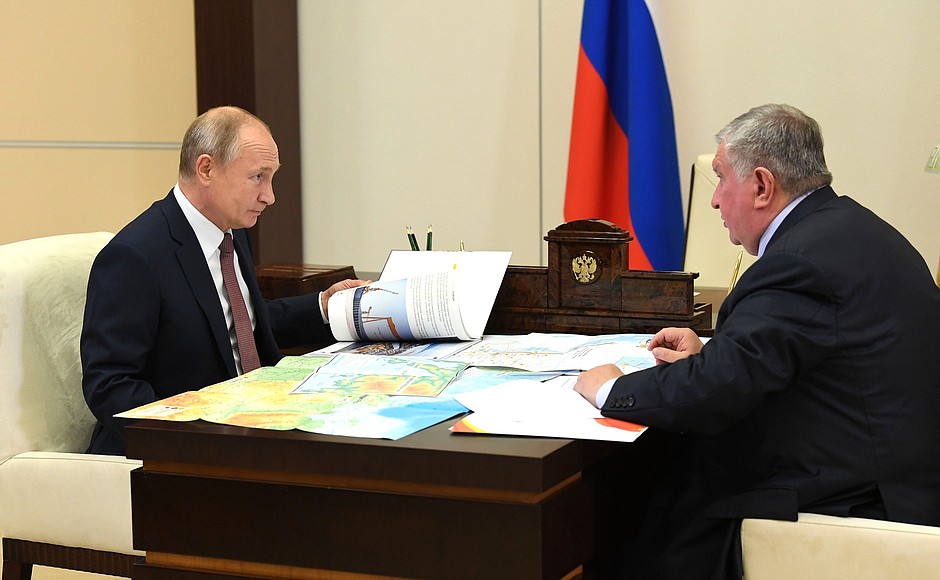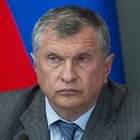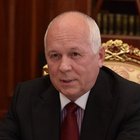
President of Russia Vladimir Putin: Good afternoon.
Mr Sechin, we obviously have many issues on the agenda, but I would like you to begin with two of them: your new northern project on Taimyr, and the Zvezda Shipyard. I see that you have the necessary materials with you. One of the problems there was the environmental impact. Let us discuss both issues.
Rosneft CEO Igor Sechin: Mr President, I will update you on the current status of the Vostok Oil project. But first, I would like to thank you for your attention to and support for this project, and especially for adopting the law under which the project received investment benefits. This has allowed us to create an economically effective model. I am pleased to tell you that we have started the practical implementation of this project.
The region where we are doing this, some 2,500 kilometres to the north of Krasnoyarsk, is actually the sphere of our operation. We are conducting exploration work in accordance with the schedule to prepare and develop the resource portfolio. We have identified the priority sites for multiple well pads; there will be up to 150 of them at the initial stage. We are also preparing a site for oil recovery and treatment units.
We have finished the survey and design stage of the project to build a pipeline, which will be 700 kilometres, or more precisely 770 kilometres long, and a port in Sever Bay.
These projects will ensure the production, transportation and transhipment of up to 50 million tonnes of oil a year at the initial stage, and up to 100 million tonnes when we complete the second stage.
The project’s infrastructure also includes the construction of 2,500 GW energy facilities and over 3,500 kilometres of power lines for the project. We have already signed a turnkey contract with Inter RAO for the construction of both power generation and grid facilities.
The project will generate extensive synergy in Russian industrial production. We have already placed an order for 10 Arc7 ice-class tankers to ship oil produced by this project. In total, there will be 50 vessels of different types servicing the project, including harbour craft, logistics vessels, large tankers and even LNG carriers.
In the interests of Vostok Oil, a long-term contract was signed on delivering up to 100 drilling units produced in Russia. These machines are equipped with modern geolocation and geosteering systems that can be bound to a specific drilling point. They stand on a hydraulic platform, which ensures more precise drilling, greater drilling speed, higher efficiency and less risk of accidents.
The drilling unit has a modular structure. Thanks to its compact size, it is almost half the size of a regular drilling rig; therefore, the investment cost of a well cluster will be 30 percent lower. It is a two-level Arctic-type drilling unit with wind protection. We have already tested it by drilling the 31st well in the West Irkinskoye area.
We had talks with KAMAZ. I spoke to Sergei Kogogin. We are going to extend our long-term supply contract with KAMAZ, which will provide additional equipment. The company will deliver 2,500 pieces of machinery, special-purpose equipment and cranes at the first stage. Subsequently, the total quantity may increase to 6,000 units.
Organising specialised maintenance centres at the locations where the machinery will operate is an important condition of our agreement with Mr Kogogin. It is very important to us.
Vladimir Putin: Will the company do it?
Igor Sechin: KAMAZ will support and maintain its machinery at our locations.
We discussed procuring helicopters as a means of transportation for the project with Rostec CEO Sergei Chemezov. Considering the fleet we already have, we spoke about getting around 50 new helicopters at the first stage.
Overall, we will need to deliver 6 million tonnes of pipe of different diameters, both for mains and for infield pipelines as well as drill pipes and casing. This will increase the workload for our metal companies and pipe producers by over 20 percent.
The project is to create tens of thousands of new jobs. It will take over 400,000 people to develop the field, including 130,000 company personnel and our contractors’ employees, plus the new jobs to be created for the project. Fifteen new towns will be built with essential infrastructure for our oil workers who will stay there in shifts.
To implement the project on schedule in terms of cargo shipment objectives set for the Northern Sea Route, we have pledged to deliver up to 30 million tonnes to the Northern Sea Route via Sever Bay by 2024. This is why it is so important for our contractors to have access to loans – not for us, but for our contractors, the equipment manufacturers who need floating capital to get started.
In this connection, I would like to ask you to help expedite the settlement of some issues in this sphere, because the existing system of support based on the leasing instruments of the State Transport Leasing Company (GTLK) will hardly be able to deal with the volumes involved in this project. Mr President, I will later report on this additionally.
Vladimir Putin: All right.
What about the Zvezda shipyard?
Igor Sechin: Mr President, here is a map of the project. This is how the completed dry dock looks. It is currently the most modern dockyard in Russia.
Vladimir Putin: Is it the largest?
Igor Sechin: Yes, it is the most modern and the largest.
Mr President, it is not just a dockyard but an entire manufacturing complex.
Vladimir Putin: No, I was asking about the dry dock. The largest dry dock.
Igor Sechin: As for the dry dock, we have completed construction and are at the pre-commissioning stage. It is a unique structure, 485 metres by 114 metres and 14 metres deep.
Vladimir Putin: It is big enough to build aircraft carriers.
Igor Sechin: Mr President, we have laid down the icebreaker Leader there.
Currently, we have completed casting concrete for the dock’s walls and bottom and are completing the service gallery. We have assembled a unique Goliath crane at the dry dock; it is the second one, with a capacity of 1,200 tonnes. Tower cranes have been manufactured and delivered to the shipyard, and a caisson for floating out finished vessels has been installed.
The construction of the new shipyard is continuing alongside production activities. Right now, 53 orders are in progress at the shipyard.
It is important to note that an entire cluster of high-tech production facilities, manufacturing the most advanced equipment, has been established around the shipyard. You have been there, and you know that they turn out screw-propeller and rudder columns, a dynamic positioning system, and other equipment.
And now, I would like to say a few words about fulfilling your instructions to provide the Zvezda complex with sheet steel. Mr President, I would like to inform you that this project is underway. We have selected a site right here.
Vladimir Putin: I see. This is Sukhodol.
Igor Sechin: It is located in a nearby harbour. МСС International Incorporation, a major company, has completed a feasibility study. They have decided that it is appropriate to build this facility in this area because we lack such production facilities.
A new steel mill with a capacity of 1.5 million tonnes will be built, with the shipyard using about 330–350 tonnes, and new regional companies will also be able to use these facilities, which will manufacture sheet metal and pipes.
Sukhodol Harbour has been selected as the most feasible site, near Bolshoi Kamen Harbour, home to Zvezda.
Overall, we will, of course, have to build additional power-generating facilities for the steel mill.
We would like to request social support, including housing and roads. This new production facility will employ about 1,500 people.
The developer estimates this project’s preliminary cost at about $2.2 billion. What presume that it will be necessary to finance this project.
Regarding support for this project, we need assistance in registering land plots as new construction sites and some assistance regarding housing and infrastructure.
Vladimir Putin: All right, let us discuss all these aspects in detail.
<…>

